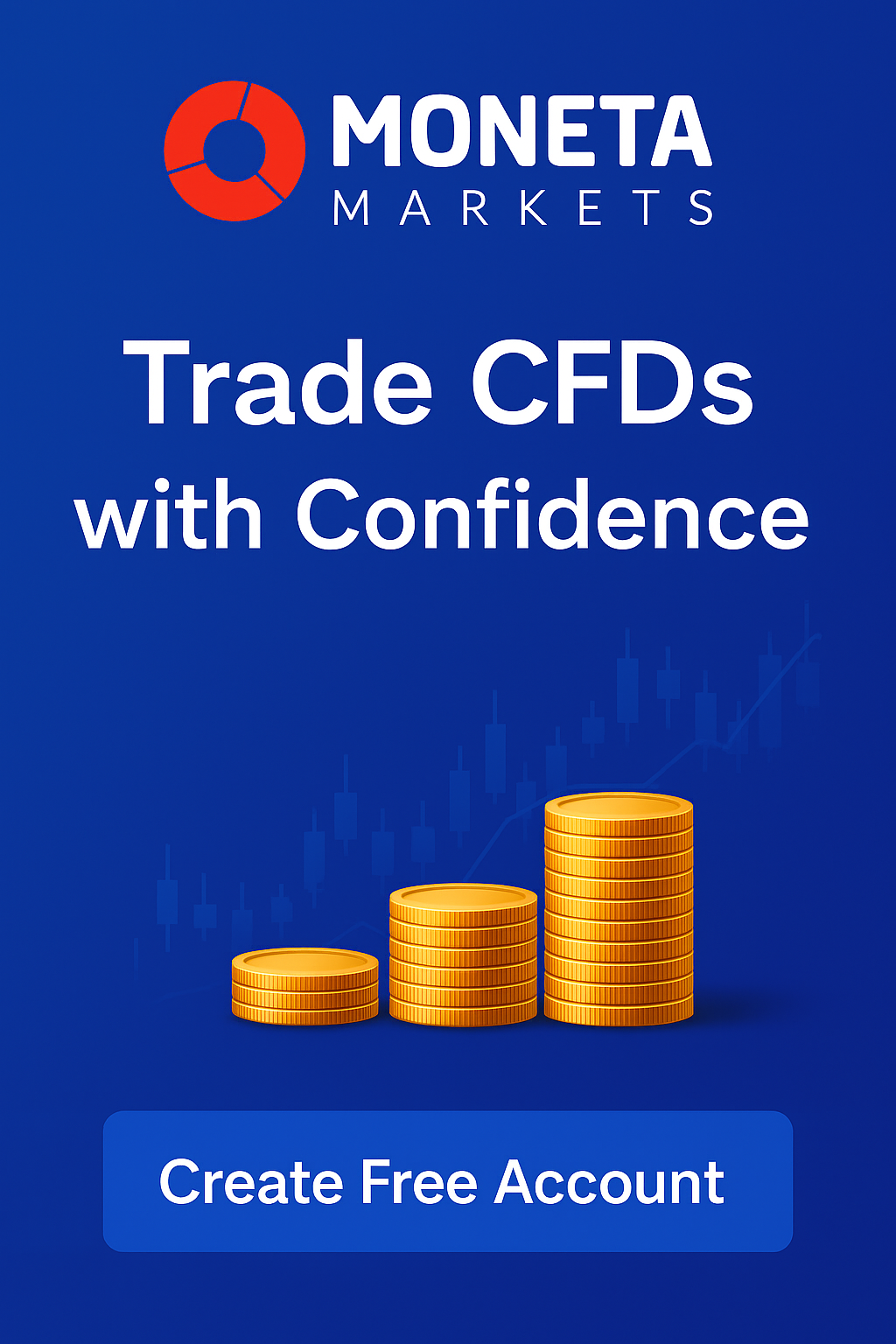CFD Trading Explained: A Comprehensive Guide to Contracts for Difference, Risks & Opportunities
Feeling lost in the world of investments after seeing your neighbor make a killing (or maybe lose it all) on U.S. stocks? Maybe you just got your paycheck and are wondering how to make it grow. Understanding the ins and outs of CFD trading can seem daunting, especially if you’re just starting out.
Are you wondering how to get started with CFD trading and what the risks are? This article will demystify Contracts for Difference (CFDs) and help you understand if they’re right for you.
What Exactly is CFD Trading?
CFD trading, short for Contracts for Difference, lets you speculate on the price movements of various assets without actually owning them. Think of it like betting on whether a stock, currency, or commodity will go up or down. It’s a popular tool, but it’s important to understand how it works before diving in.

Contracts for Difference (CFDs) Defined
A Contract for Difference (CFD) is essentially an agreement between two parties to exchange the difference in the price of an asset from the time the contract opens until it closes. You’re not buying or selling the actual asset, like a share of Apple stock. Instead, you’re trading based on the predicted price movement of that asset.
This makes it a derivative product. For example, you can trade CFDs on gold, even if you don’t own any physical gold.
Speculating vs. Owning: The Key Distinction
The biggest difference between CFD trading and traditional investing is that you don’t own the underlying asset. When you buy a stock, you become a shareholder and own a piece of the company. With CFDs, you’re simply speculating on the price movement.
This also means you don’t receive dividends or voting rights. CFDs are purely about price speculation.
Understanding the ‘Difference’ in CFD
The “difference” in CFD refers to the price difference between the opening and closing of your trade. If you predict correctly and the price moves in your favor, you’ll profit from that difference. Conversely, if the price moves against you, you’ll incur a loss.
For example, if you buy a CFD on a stock at $100 and sell it at $110, you’ll profit $10 per CFD. However, if the price drops to $90, you’ll lose $10 per CFD.
How Does CFD Trading Work? Mechanics & Practical Examples
CFD trading involves several key mechanics, including leverage, margin, and the ability to go long or short. Understanding these aspects is crucial for making informed trading decisions. Let’s break them down with relatable examples for Taiwanese investors.

Leverage and Margin: Magnifying Your Trades
Leverage allows you to control a larger position with a smaller amount of capital. It’s like using a small down payment to buy a much bigger house. Margin is the initial deposit required to open and maintain a leveraged position.
For example, if a broker offers 10:1 leverage, you can control a position worth $10,000 with just $1,000 of your own capital. However, remember that leverage magnifies both profits and losses.
Going Long vs. Going Short: Profiting from Any Market Direction
In CFD trading, you can profit from both rising and falling markets by going long or short. Going long means you’re betting the price will increase, while going short means you’re betting the price will decrease.
If you think TSMC stock will rise, you’d “go long.” If you think it will fall, you’d “go short.”
A Step-by-Step CFD Trade Example
Let’s illustrate with a simple example. Imagine you want to trade a CFD on Taiwan Semiconductor Manufacturing (TSMC) stock.
- You believe TSMC’s price will rise, so you decide to go long.
- The current price is NT$600 per share.
- You buy 100 CFDs on TSMC, requiring a margin of 5%.
- Your margin deposit is NT$600 x 100 x 5% = NT$3,000.
- If TSMC’s price rises to NT$610, you sell your CFDs, making a profit of (NT$610 – NT$600) x 100 = NT$1,000.
- However, if the price falls to NT$590, you’ll lose (NT$600 – NT$590) x 100 = NT$1,000.
Remember, this example doesn’t include broker fees or other potential costs.
The Diverse Markets and Potential Advantages of CFD Trading
CFD trading offers access to a wide range of global markets, from stocks and forex to commodities and indices. This versatility, combined with other potential benefits, makes it an appealing option for some traders. But remember, “potential” doesn’t guarantee success.

Accessing Global Markets: Shares, Forex, Commodities & More
CFDs allow you to trade on the price movements of various assets without needing to directly own them. You can speculate on the performance of U.S. stocks, even if you’re based in Taiwan. Similarly, you can trade currencies like the USD/TWD pair or commodities like gold and oil.
This can be easier and more cost-effective than directly trading in foreign markets.
Flexibility and Liquidity: Why Traders Consider CFDs
CFD markets are generally very liquid, allowing you to enter and exit trades quickly. The ability to go both long and short provides flexibility to profit from rising or falling markets. This is particularly useful in volatile markets.
Imagine being able to profit even when the stock market is crashing. CFDs make that possible.
Relative Cost Efficiency and Accessibility
CFD trading can be more cost-effective compared to traditional trading, especially with lower commissions and margin requirements. However, it’s important to factor in overnight funding charges and other potential fees. Many online brokers offer access to CFD trading platforms, making it easily accessible.
But don’t let the accessibility fool you; CFD trading is not a “get rich quick” scheme.
The Significant Risks Associated with CFD Trading
CFD trading carries substantial risks that beginner investors often underestimate. Leverage, market volatility, and a high rate of losses among retail traders make it crucial to understand these risks before getting started. This isn’t like buying a cup of bubble tea; it’s serious business.

The Double-Edged Sword of Leverage: Amplified Losses
While leverage can magnify profits, it can also amplify losses significantly. A small adverse price movement can wipe out your entire margin deposit. It’s like driving a sports car; it’s fun but requires extreme caution.
For example, if you use 10:1 leverage and the asset price moves against you by just 10%, you could lose your entire investment.
Market Volatility and Unpredictability
CFD markets are often highly volatile, making price movements unpredictable. Unexpected news events, economic data releases, or even rumors can cause sudden and significant price swings. These swings can trigger margin calls and lead to substantial losses.
Imagine the price of your favorite stock suddenly dropping 20% overnight. Could you handle that?
Why Most Retail CFD Accounts Lose Money: A Reality Check
A large percentage of retail CFD traders lose money. This is due to a combination of factors, including lack of experience, poor risk management, and emotional decision-making. CFD trading is not a guaranteed path to riches.
Treat it like a serious profession that requires extensive knowledge and discipline. A common beginner mistake is thinking that CFD trading is easy money. It requires skill and careful planning.
CFD Trading Legality and Suitability: Is It Right for You?
Before engaging in CFD trading, it’s essential to understand the regulatory landscape and assess whether it aligns with your financial situation and risk tolerance. CFD trading isn’t legal everywhere, and even where it is, it might not be suitable for everyone. It depends on your personal circumstances.
Understanding CFD Regulations by Region (e.g., US Restrictions)
CFD trading is not legal in all countries. For example, it’s heavily restricted in the United States due to regulatory concerns. Before trading CFDs, ensure it’s legal in your jurisdiction and understand the local regulations.
Check with your local financial regulatory authority for the most up-to-date information.
Assessing Your Personal Risk Tolerance and Capital
Consider your risk tolerance and financial situation carefully before trading CFDs. Can you afford to lose the money you’re investing? Are you comfortable with the high level of risk involved? If not, CFD trading might not be for you.
Only risk capital that you can afford to lose without impacting your financial stability.
When CFD Trading Might (and Might Not) Be a Good Idea
CFD trading might be suitable for experienced traders with a high-risk tolerance who understand the complexities of the market. It may not be suitable for beginners or those with limited capital. If you’re new to trading, start with less risky investments and gradually build your knowledge and experience.
It’s better to start small and learn as you go, rather than jumping in headfirst and losing everything.
Choosing a CFD Broker and Getting Started Responsibly
Selecting a reputable CFD broker and implementing sound risk management strategies are crucial for responsible trading. Not all brokers are created equal, and proper risk management can help protect your capital. Think of it like choosing a reliable driving instructor and learning defensive driving techniques.
Key Factors When Selecting a Reputable CFD Platform
Consider the following factors when choosing a CFD broker: regulation, reputation, trading platform, fees, and customer support. Ensure the broker is regulated by a reputable financial authority. Read online reviews and compare different platforms to find one that suits your needs.
Look for brokers that offer educational resources and excellent customer service.
Utilizing Demo Accounts: Your Essential Learning Tool
Before risking real money, practice with a demo account. A demo account allows you to trade with virtual money in a real-time market environment. This is an invaluable tool for learning the ropes and testing your trading strategies without financial risk.
Treat your demo account like a real account and take your trades seriously.
Essential Risk Management Strategies for Beginners
Implement essential risk management strategies such as setting stop-loss orders and managing your leverage. A stop-loss order automatically closes your position when the price reaches a certain level, limiting your potential losses. Avoid using excessive leverage and only risk a small percentage of your capital on each trade.
A good rule of thumb is to risk no more than 1-2% of your capital on any single trade.
Ready to explore the world of CFD trading? Practice your strategies in a risk-free environment with a free demo account, or download our comprehensive guide on advanced risk management techniques for informed decision-making.


No responses yet